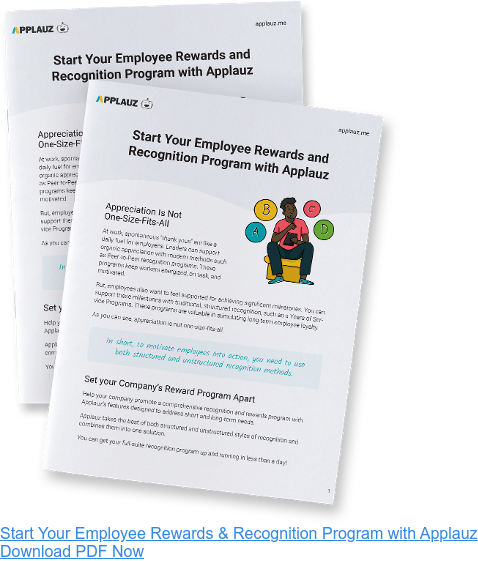As an HR leader, you’re likely aware of how important recognition and appreciation are in the workplace.
Research shows employees who receive recognition are more productive and engaged at work. At the same time, a lack of recognition is one of the leading causes of employee burnout.
Not all recognition feels impactful
Even though recognition is crucial, it’s important to remember not all praise is created equal.
There’s a difference between saying “thank you” while walking out the door and taking time to express what you value about an employee.
That said, your company may have a difficult time getting employees to prioritize even basic appreciation. Managers might drag their feet or claim they already give enough recognition.
This might be true for a handful of top managers. Yet, a disconnect exists between how good managers think they are at giving recognition and how appreciated their employees actually feel.
Struggling to prioritize recognition
That said, maybe your business already supports recognition. For example, through more formal systems like a length of service program or annual evaluations. Budget-conscious executives may believe that these practices are enough to support appreciation.
These structured forms of recognition are essential yet happen rarely. As a case in point, most employees won’t even make it to their 5th anniversary, usually the first milestone in a work anniversary program.
So how can a company support appreciation in a consistent and lasting way?
Without a Peer-to-Peer program in place, systemically promoting appreciation and recognition would be nearly impossible.
A Peer-to-Peer recognition program is an essential tool to help businesses support appreciation. It gives employees a place to recognize each other with greater frequency and visibility.
Let’s dig a little deeper to define the many ways a peer recognition program can help businesses make recognition and appreciation a real and lasting priority.
Greater Appreciation: How a Peer Recognition Program Will Help Your Company Get There

1 - Creates a dedicated space for employees to support and encourage each other
How do employees give each other recognition in your company? Probably through email or chat. Or maybe managers offer a quick “good job” during team meetings. Essentially, appreciation is likely shared haphazardly and mainly in 1:1 meetings.
If you want to support recognition within your company, the most critical first step is to create a dedicated space for appreciation.
This space can be physical or virtual. For instance, creating space can mean periodically hosting "appreciation meetings" or creating a "recognition" channel in your company's chat tool.
However, an official recognition program can take care of that work for you. Peer-to-Peer recognition tools, like Applauz, offer companies a digital platform just like social media where employees exchange appreciation.
Having a dedicated digital space provides a multitude of benefits. Namely, people who might be shyer will feel more compelled to share because the platform creates a “safe space” to express gratitude. Unlike face-to-face interactions, which can be stress-provoking for some, giving recognition through a digital platform will never feel uncomfortable, forced, or awkward. This brings us to our next point.
uncomfortable, forced, or awkward. This brings us to our next point.
2 - Gives employees an opportunity to personalize their recognition
Think about how your company managers typically express appreciation to employees. Perhaps they give recognition during formal evaluations. Or maybe they occasionally offer their entire team gift cards and a sweeping "good job, team."
Either way, these popular methods of recognition lack two critical things: frequency, and most importantly, personalization.
For instance, if managers give everyone the same gift card and a catch-all "thank you." It's a nice gesture but lacks meaning. The recognition is not specific to any employee. On the other hand, the type of praise that truly energizes an employee is personal. In other words, employees want to feel seen and valued for what they bring to the table.
That's why a peer recognition program is so beneficial, as it allows managers to give personalized recognition. Also, recognition is written, so employees can reflect on what they want to say and draft a great statement. A bonus: shyer team members will not feel unnecessary pressure to verbally express their appreciation on the spot. Sometimes it's easier to express gratitude by writing it out! As a result, recognition messages will always be rich and meaningful.
3 - Helps to measure recognition efforts and holds managers accountable
Your company may already use practices to make sure employees feel valued and appreciated. For example, work anniversaries or ad-hoc recognition, like managers stopping by an employee's desk to say "thank you."
Giving some recognition is better than nothing. But as said before, not all recognition is created equal.
The quality of a manager's recognition is critical. And the hard truth is many employees simply don't feel valued even though their managers claim to give appreciation.
That said, recognition is a major pillar of an employee engagement strategy. So If your business wants to improve employee engagement, HR should have an overview of your business's recognition efforts -- in terms of quality and quantity of recognition.
In other words, without a program, it's difficult (if not impossible) for company leaders to objectively assess how well the company is doing in terms of recognition. That is unless HR sits in on 1:1 meetings or reads every anniversary card. We all know this is never going to happen!
Bottom line: With a peer recognition system, HR has full transparency. And most importantly, it allows you to quantify your company's recognition efforts. As such, your team can oversee which managers are making efforts and spot those who need to step it up. And you can even develop strategies to help managers give richer, more meaningful recognition.
4 - Encourages recognition in every direction
Traditionally speaking, workplace recognition is given from the top down. In other words, the manager is the one who offers recognition to an employee.
This type of system has a major shortcoming; it doesn’t consider that even managers and leaders want to feel appreciated.
When managers don’t feel appreciated, they too are likely to feel disengaged and burnout.
As a result, they are less likely to support their employees, and the cycle of burnout continues. As such, a program where employees can offer appreciation in any direction is so powerful.
With a Peer-to-Peer system, coworkers can support each other with appreciation. And most importantly, employees can even recognize their managers! In short, everyone receives recognition and reaps the benefits of feeling valued and appreciated.
5 - Recognition is spontaneous and sincere
Traditional forms of recognition, like yearly evaluations, typically center around performance. In short, employees are praised for their productivity — for example, meeting sales goals or deploying that new feature. It's important to praise employees who meet the organization's goals. But focusing too much on celebrating performance has some major drawbacks.
First, recognition that is only based on performance can seem impersonal and makes workers feel like just another productivity unit (and less like an individual human).
Second, performance-based systems (like employee of the month programs) can lead to a bias where only a handful of top performers receive regular praise. While other team members -- who contribute to a team, just in less visible ways -- feel left out.
To be clear, managers should praise employees who raise the bar and achieve goals. However, managers should also highlight the character, skills, and talents that helped the entire team attain those goals.
For example, by celebrating an employee for their quiet dedication, supportive attitude, or wonderful sense of humour.
Consequently, employees who played less visible roles also get recognized. And as a result, all workers will feel deeply valued and energized.
A peer recognition program creates a space for managers to share this type of informal appreciation -- one that is not always centred around performance. In short, recognition can be expressed in a fun and relaxed way. Ultimately, making praise feel more genuine and sincere.
6 - Recognition can be offered at a greater frequency
A peer recognition program's beauty is that employees don't need to wait for a formal sit-down meeting with a manager to receive praise.
An appreciation message of any length can be written and sent at any time. This flexibility allows managers and employees to share appreciation at a greater frequency with no waiting time, obstacles, or barriers.
7 - Recognition is visible to everyone
Sometimes managers make a point to give shout-outs during team meetings. But, most often, employees will only receive praise in 1:1 meetings or maybe informally if a manager pops into an employee's office to say "good job."
These recognition actions are beneficial, but the major drawback is an employee doesn't have the chance to share their success with anyone else.
Respect and praise from peers can be potent motivators for employees.
That's why an important advantage of a peer recognition program is it allows for full transparency. Unless made private, recognition messages are "broadcast" to the entire department or company.
Knowing everyone can see the great job you did can feel energizing to the person receiving the attention. It shines a light on their unique skills, talents, and accomplishments.
8 - Appreciation and gratitude become a regular practice
Think about how social media has become a regular part of our daily life — checking messages and writing comments. Over time, we incorporated the use of these digital platforms into our normal routines. Maybe even too much for some people!
The same outcome happens when teams make a recognition program part of their routine. With a recognition platform, expressing appreciation and gratitude becomes a regular part of everyone's workweek.
For example, an employee received help from a colleague on a presentation, they will log into the program and quickly give them a shout-out. Giving recognition won't be something you have to remember to do. It will simply be second nature. In other words, appreciation will become a new, positive habit everyone lives by.
9 - Allows remote teams to stay connected
With so many people working from home, even teams who were great at giving recognition might find themselves dragging their feet on showing appreciation. Understandably, the remote work setting can make it difficult for teams to share gratitude for each other.
A Peer-to-Peer recognition program supported by a digital platform, like Applauz, is perfect for remote teams. The system gives employees (wherever they may be in the world) a dedicated space to share and celebrate each other’s achievements. Despite the distance, they can keep making appreciation a priority.
Final Thoughts
As you can see there are many ways an official peer recognition program can help your company step up its appreciation habits and turn recognition into regular practice.
A peer recognition program is essential because it sets the parameters appreciation-shy employees need. As such, it helps them stay motivated and on track towards healthier relational habits.
Finally, the beauty of this type of program is that it's simple and fast to put in place. And unlike other initiatives in your HR Strategy that can take weeks to roll out, and many months before you see an impact, a peer recognition program can be up and ready in less than a day. And the positive feelings start flowing as soon as the first recognition message is sent!
About the author
 Michelle Cadieux
Michelle Cadieux
Michelle is a content writer for Applauz. She holds a Bachelor's degree in Psychology from Concordia University, and she has been writing about work and employee happiness for over five years.



